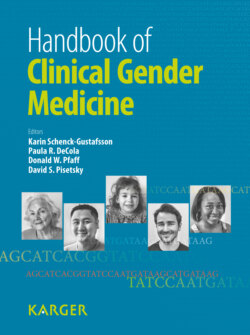Читать книгу Handbook of Clinical Gender Medicine - Группа авторов - Страница 46
На сайте Литреса книга снята с продажи.
The Sexual Dimorphous Brain – Organizational and Activational Effects of Sex Hormones
ОглавлениеHormones seem to exert a bitemporal effect on the brain. The organizational effect induces specific cell processes, occurs during intrauterine life, and permanently determines the development and function of sex organs, the brain, and other bodily systems. The activational effects may be transient or permanent, may occur throughout life, or may not occur at all. While this two-process theory has been challenged as being overall simplicist, it is helpful for the purpose of understanding the way sex hormones affect our brain. Juvenile play behavior has been used traditionally as an indicator of the degree of masculinization or feminization of offspring. Organizational and activational effects of testosterone also seem to be involved in inflammatory pain and response to morphine analgesia. This may explain the reported higher pain thresholds in men compared to women.
The sexual dimorphous development of the brain has fascinated researchers for over a century [9] and it is now generally accepted that fetal testosterone secretion plays a crucial role in the differentiation process. This has been demonstrated in animal studies as well as in humans [9]. Sex dimorphism of the human brain is evident at the cellular level, in the synaptic and dendritic organization, and also in the volume of specific cell groups and nuclei [7]. In the rat brain, the sexually dimorphic nucleus of the preoptic area (which also has a human equivalent) is such an example. In the human brain, dimorphic changes have been reported in the hypothalamus, cortex, and amygdale. Of great importance in this context is the hypothalamus which governs central functions like reproduction, eating, and sleeping. Gender differences in these major functions are partly a result of brain dimorphism. These differences are governed to a great extent by intrauterine levels of sex hormones, which exert organizational and activational effects. With the advent of functional MRI the brain, as the most complex organ in the human body, has become more accessible to functional neuroresearch. Moreover, while until rather recently it has been assumed that the brain, once established, is no longer capable of neurogenesis, there is now evidence that in primates new neurons are being created throughout life in various parts of the neocortex. This phenomenon of brain plasticity which includes anatomical and functional changes of the brain in response to environmental stimuli is of paramount importance and reflects the sensitivity of the brain to input. Again [3], an eminent genetician has stated that: ‘from the perspective of brain neuroscience, the environmental world of the developing embryo and fetus is as important as any information by the genes’. If both sides of the brain were to be constructed as mirror images, like mirrored hard disks, the resulting redundancy would provide a readily available repair resource to correct focal insults. Nature has implemented such a strategy for chromosome pairs but not for the brain. Here nature has opted mainly for maximal usage of available ‘real estate’ resources at the expense of redundancy. Therefore many (but not all) activity centers in the brain are unilateral. This modification of lateralization is neither predetermined solely by genetics nor absolute. Sex differences in lateralization have been the object of great scientific interest and the functional organization of laterality of language function has been of particular interest. Several language-related tasks are more left lateralized in males and more bilateralized in females. The corpus callosum is the main conduit of information between the two hemispheres of the brain and any asymmetric development may affect intrabrain connectivity between homologous and heterologous brain foci. Not only the corpus callosum but also the hemispheres show sexual differences which are related to fetal testosterone levels. Increased fetal testosterone levels in the male lead to a smaller corpus callosum and hence decreased connectivity between the left and the right brain. This may be the cause for greater lateralization of various cognitive functions and may explain why females use both sides of their brains more easily [7]. Using high resolution MRI in a cohort of 28 boys whose mothers had undergone second trimester amniocentesis, Chura et al. [9] studied the correlation of fetal testosterone levels with the size and the symmetry of the corpus callosum. The authors observed a positive correlation between fetal testosterone levels and increasing rightward asymmetry of a posterior subsection of the corpus callosum leading to an increased size of the right part of this particular segment.
